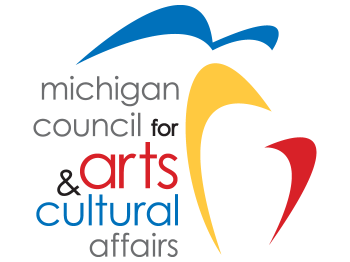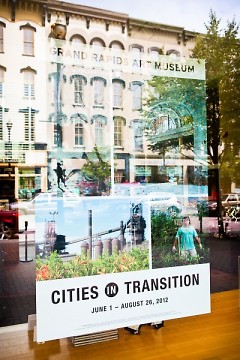“Cities in Transition,” the Grand Rapids Art Museum (GRAM)’s new exhibit, invites the discussion about what is required of our cities to remain relevant as we, and our cultures and expectations, evolve over time.The exhibit, which spans the first two floors of the museum, largely features photographs that offer alternative perspectives, not only on settings within Grand Rapids that we encounter often and know very well, but also commentary on cities worldwide as well as the state of Detroit and what lies ahead in its evolution. Through a combination of two different galleries, the exhibit displays the result of Detroit’s sixty-year-long decline. The first, “Detroit Disassembled,” features Andrew Moore’s haunting photographs of abandoned sites and buildings throughout the city. The second, “Reinvention: Rouge Photographs,” features Michelle Andonian’s series documenting the evolution of the auto industry. The lasting image created by these two series is that of a city in ruins, but one that is not without hope. Some well-placed informational panels, and a series documenting slow but continually growing and resurging communities in Detroit leave room for the possibility of Detroit’s eventual comeback. The sentiment created by these elements lends credence to the city’s motto: “Speramus Meliora; Resurget Cineribus,” which translates to “we hope for better things; it will arise from the ashes.”
The exhibit also offers a look into Grand Rapids’ history and evolution as an urban setting. The exhibit “What Happened Here?” focuses on the growth and changes downtown Grand Rapids and Rosa Parks Circle have undergone. Downtown’s structure experienced a lot of false starts before the area we know today was constructed. Rosa Parks Circle in particular failed substantially at first to generate any interest from Grand Rapids’ citizens as a place to gather and socialize. It wasn’t until the city hired renowned artist Maya Lin (perhaps most recognized for her design of the Vietnam Veteran's Memorial in Washington, D.C.) to re-imagine and reconstruct the space that Rosa Parks Circle’s true potential as Grand Rapids’ hub was realized. The exhibit features photos, old maps of Grand Rapids, condensed regional history lessons and a video of Maya Lin discussing her process.
The fourth component of Cities in Transition, called “Perspectives on the City,” features prints, drawings, lithographs and photographs displaying artists’ varying impressions and representations of urban landscapes from around the world. Though ultimately less engaging than the other exhibits, “Perspectives on the City” does create an interesting timeline of urban evolution around the world. What is particularly striking is how similar different cities can be, both in appearance and atmosphere, regardless of their geographical or sometimes even their geopolitical location. All cities have been influenced by cities that came before them, and they will continue to evolve in a similar vein. “Cities in Transition” offers a highly educational, thoughtful and timely examination of our contemporary urban environments. It asks the viewer to contemplate what will be required of our cities tomorrow. “Cities in Transition” asks how urban residents, as the cities' inhabitants, can rise to the challenge and ease our cities into the future.
The Rapidian, a program of the 501(c)3 nonprofit Community Media Center, relies on the community’s support to help cover the cost of training reporters and publishing content.
We need your help.
If each of our readers and content creators who values this community platform help support its creation and maintenance, The Rapidian can continue to educate and facilitate a conversation around issues for years to come.
Please support The Rapidian and make a contribution today.



